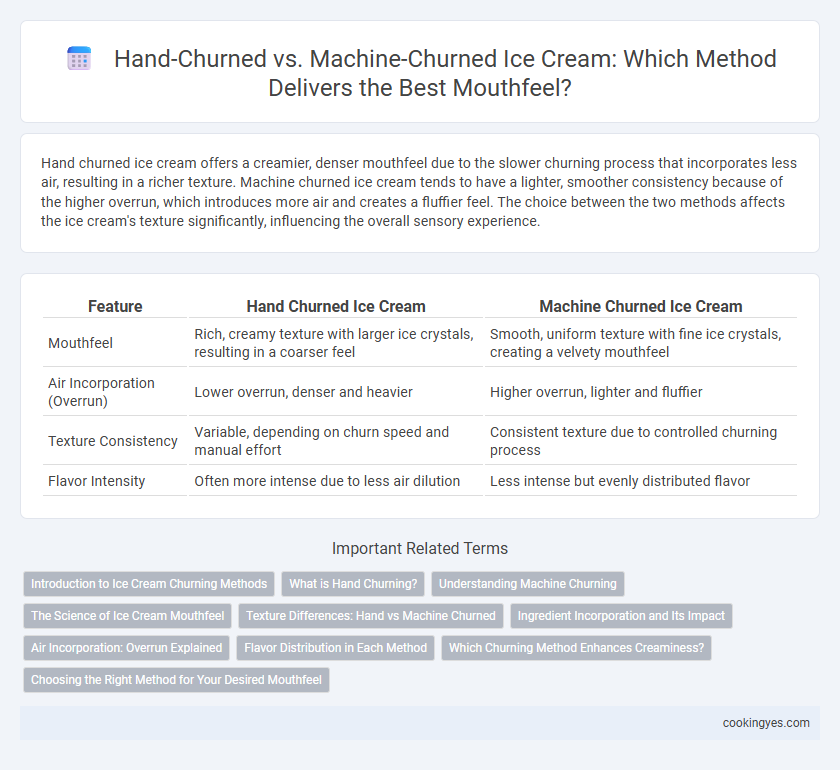Hand churned ice cream offers a creamier, denser mouthfeel due to the slower churning process that incorporates less air, resulting in a richer texture. Machine churned ice cream tends to have a lighter, smoother consistency because of the higher overrun, which introduces more air and creates a fluffier feel. The choice between the two methods affects the ice cream's texture significantly, influencing the overall sensory experience.
Table of Comparison
| Feature | Hand Churned Ice Cream | Machine Churned Ice Cream |
|---|---|---|
| Mouthfeel | Rich, creamy texture with larger ice crystals, resulting in a coarser feel | Smooth, uniform texture with fine ice crystals, creating a velvety mouthfeel |
| Air Incorporation (Overrun) | Lower overrun, denser and heavier | Higher overrun, lighter and fluffier |
| Texture Consistency | Variable, depending on churn speed and manual effort | Consistent texture due to controlled churning process |
| Flavor Intensity | Often more intense due to less air dilution | Less intense but evenly distributed flavor |
Introduction to Ice Cream Churning Methods
Hand churned ice cream offers a uniquely creamy and dense mouthfeel due to slower freezing and the incorporation of larger ice crystals, which enhance texture and richness. Machine churned ice cream, produced with high-speed motors and continuous agitation, creates finer ice crystals that deliver a smoother, lighter mouthfeel preferred in mass-produced varieties. Understanding these churning methods highlights the balance between artisanal texture and commercial consistency in ice cream production.
What is Hand Churning?
Hand churning is a traditional ice cream-making method that involves manually rotating a handle to agitate the ice cream mixture, which incorporates air and creates a denser, creamier texture. This process allows for more precise control over the creaminess and ice crystal size, resulting in a smoother mouthfeel compared to many machine-churned varieties. The slower, gentler churning minimizes over-aeration, enhancing the rich, velvety consistency prized in premium ice creams.
Understanding Machine Churning
Machine churning produces ice cream with a finer, smoother mouthfeel due to consistent and rapid mixing that incorporates smaller air bubbles. This method controls overrun effectively, resulting in a dense yet creamy texture favored in commercial ice cream production. Understanding machine churning reveals how precise temperature regulation and continuous agitation enhance the ice cream's velvety feel compared to the coarser texture typical of hand-churned varieties.
The Science of Ice Cream Mouthfeel
Hand churned ice cream typically has larger ice crystals due to slower freezing, resulting in a coarser texture and less smooth mouthfeel compared to machine churned varieties. Machine churning rapidly freezes the mixture while incorporating air, creating smaller ice crystals and a creamier, more consistent texture that enhances sensory enjoyment. The science of ice cream mouthfeel hinges on ice crystal size and air incorporation, both critical factors influenced by the churning method to optimize smoothness and creaminess.
Texture Differences: Hand vs Machine Churned
Hand churned ice cream offers a creamier, denser texture due to slower churning that incorporates larger fat globules and less air, enhancing mouthfeel richness. Machine churned ice cream typically has a lighter, smoother consistency with more incorporated air (overrun), resulting in a fluffier texture. The contrast in fat crystallization and air incorporation directly affects the tactile sensation, making hand churned varieties feel more substantial and velvety compared to the lighter, more uniform texture of machine churned ice cream.
Ingredient Incorporation and Its Impact
Hand churned ice cream exhibits a coarser mouthfeel due to less consistent ingredient incorporation, resulting in a more varied texture with larger ice crystals. Machine churned ice cream achieves finer, smoother mouthfeel by evenly blending air, fat, and sugar, producing a stable emulsion and smaller ice crystals for enhanced creaminess. The uniformity of ingredient distribution in machine churned ice cream significantly impacts the sensory experience, offering a richer and more velvety texture compared to traditional hand churning methods.
Air Incorporation: Overrun Explained
Hand-churned ice cream typically features lower air incorporation or overrun, resulting in a denser and creamier mouthfeel compared to machine-churned varieties. Machine-churned ice cream can achieve higher overrun, sometimes up to 100%, which lightens texture but may reduce richness and intensity of flavor. Overrun directly influences the smoothness and perceived quality, making air content a crucial factor in the sensory experience of ice cream.
Flavor Distribution in Each Method
Hand churned ice cream offers a denser, creamier mouthfeel due to slower churning, allowing larger ice crystals to develop and enhancing flavor pockets with richer, varied intensity. Machine churned ice cream typically produces a smoother, lighter texture with uniformly small ice crystals, promoting consistent flavor distribution but sometimes diluting the intensity of individual taste notes. Flavor molecules in hand churned ice cream tend to remain more concentrated in localized areas, while machine churning disperses flavors evenly throughout the product.
Which Churning Method Enhances Creaminess?
Hand churned ice cream typically offers a denser, creamier mouthfeel due to slower churning that incorporates less air, resulting in a richer texture. Machine churned ice cream often contains more air, creating a lighter, softer consistency but potentially reducing the overall creaminess. The controlled, slower agitation of hand churning preserves fat globules, enhancing the smooth, velvety sensation preferred in premium ice cream.
Choosing the Right Method for Your Desired Mouthfeel
Hand churned ice cream offers a denser, creamier mouthfeel with larger ice crystals that melt slowly, providing a rich texture favored in artisanal recipes. Machine churned ice cream produces a smoother, more consistent texture with smaller ice crystals, resulting in a lighter mouthfeel ideal for commercial varieties. Selecting the right method depends on whether a thick, rustic texture or a silky, uniform mouthfeel is preferred.
Hand Churned vs Machine Churned for Mouthfeel Infographic

 cookingyes.com
cookingyes.com